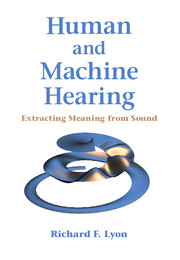Book contents
- Frontmatter
- Dedication
- Contents
- Foreword
- Preface
- Part I Sound Analysis and Representation Overview
- 1 Introduction
- 2 Theories of Hearing
- 3 On Logarithmic and Power-Law Hearing
- 4 Human Hearing Overview
- 5 Acoustic Approaches and Auditory Influence
- Part II Systems Theory for Hearing
- Part III The Auditory Periphery
- Part IV The Auditory Nervous System
- Part V Learning and Applications
- Bibliography
- Author Index
- Subject Index
- Plate section
3 - On Logarithmic and Power-Law Hearing
from Part I - Sound Analysis and Representation Overview
Published online by Cambridge University Press: 28 April 2017
- Frontmatter
- Dedication
- Contents
- Foreword
- Preface
- Part I Sound Analysis and Representation Overview
- 1 Introduction
- 2 Theories of Hearing
- 3 On Logarithmic and Power-Law Hearing
- 4 Human Hearing Overview
- 5 Acoustic Approaches and Auditory Influence
- Part II Systems Theory for Hearing
- Part III The Auditory Periphery
- Part IV The Auditory Nervous System
- Part V Learning and Applications
- Bibliography
- Author Index
- Subject Index
- Plate section
Summary
The task of clearing the scientific bench top of the century-long preoccupation with the jnd [just-noticeable difference], and the consequent belief in logarithmic functions, demands the cleansing power of a superior replacement. My optimism on this score has been recorded in other places, but I would like here to suggest that, if I seem to feel a measure of enthusiasm for the power law relating sensation magnitude to stimulus intensity, it is only because that law seems to me to exhibit some highly desirable features.
—Stevens (1961), “To honor Fechner and repeal his law: a power function, not a log function, describes the operating characteristic of a sensory system”Logarithms, exponentials, and power laws appear frequently in signal analysis, and especially in hearing-motivated techniques. It is important to understand the reasons for their use, and to be able to recognize when they are inappropriate, and how to modify such mappings to make them more practical and robust.
Logarithms and Power Laws
Engineers like to describe signals and their spectra—and systems that process them—in logarithmic units. Our hearing is sometimes described as logarithmic, along both the loudness dimension and the pitch (or frequency) dimension. So we need to understand what this means, what's powerful and useful about logarithms, and what their limitations are as a conceptual model for perception of loudness and pitch in hearing.
As the Britannica (1797) cryptically explains, logarithms are “the indices of the ratios of numbers to one another; being a series of numbers in arithmetical progression, corresponding to others in geometrical progression; by means of which, arithmetical calculations can be made with much more ease and expedition than otherwise.” That is, logarithms were an invented way to make multiplication not much harder than addition, long before the logarithm was understood as a mathematical function. The logarithm function is also of great importance as the inverse of the exponential function, as we discuss in a later section.
A power law, on the other hand, is a remapping through a power, or exponentiation, such as a square, or a square root. Power laws also come in function/inverse pairs: the square and square root, or cube and cube root, or Nth power and Nth root (1/N power) in general, are such pairs.
Information
- Type
- Chapter
- Information
- Human and Machine HearingExtracting Meaning from Sound, pp. 33 - 45Publisher: Cambridge University PressPrint publication year: 2017
